Spring 2018
Above: Jillian Belgrad ’17 conducts research on Gulf War Illness at the National Institutes of Health.
STORY BY DANIEL DEVRIES / PHOTOS BY MARK DIORIO
At the National Institutes of Health (NIH) in Bethesda, Md., Colgate alumni are on the front lines of scientific efforts to combat infectious and chronic diseases ranging from HIV to cancer to Alzheimer’s.
Several of these alumni started working in the same labs as students participating in Colgate’s NIH Study Group, which was formed in 1992 and is the only one of its kind in the country. The program affords select students the opportunity to spend an entire semester at the nation’s leading health care research facility, often working side by side with scientists on the cusp of major discoveries.
Students interested in medical or health care careers endure a rigorous selection process. Only rising seniors majoring in neuroscience, biology, molecular biology, biochemistry, or chemistry may apply to participate in the program. Students interested in the group are often mentored by professors in those departments, and they must have a solid academic record to ensure they are prepared for the challenges that await at the NIH.
“It takes almost a year to select students,” explains Associate Professor of Biology Engda Hagos, who led the group last fall. “We require two or three referrals from professors, and we interview each student and review their applications. We want to know they’ve worked in a lab or have research experience. This is the best place for research, so the students need to be invested in doing the work. It’s not easy.”
Now, step into the labs to visit with students in Colgate’s 25th NIH study group and two alumni post-baccalaureate researchers.
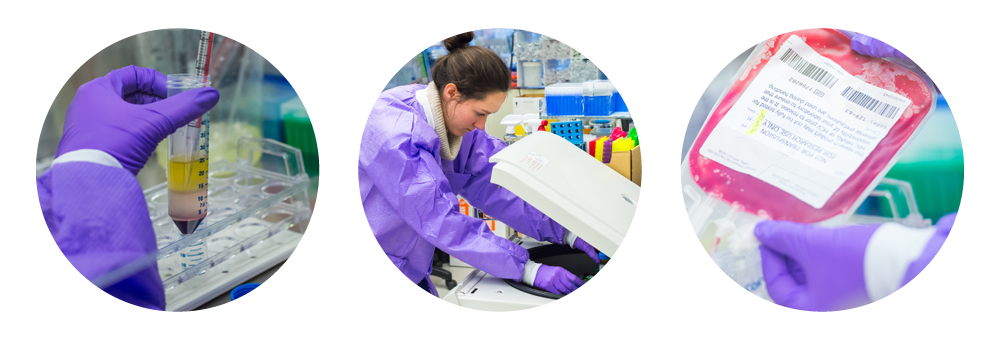
Erin Huiting ’17
Molecular biology major
Evergreen, Colo.
IRTA Fellow at National Institute of Allergy and Infectious Diseases
Erin Huiting spends her days, and sometimes nights, working to find a cure for HIV.
“My lab is focused on developing novel therapeutic options aimed at achieving an HIV cure,” Huiting says. “What does ‘cure’ really mean? In this sense, we’re striving for controlling and suppressing the virus in absence of antiretroviral therapy. This is known as the sustained virological remission.”
For traditional diseases, a cure would simply involve eliminating the pathogen, but the complication with HIV is how the virus infects immune cells and remains inactive, often persisting without a sign until a patient is taken off of drug therapy, Huiting explains.
“So, rather than just finding an antiretroviral therapy that can purge or eliminate the virus, we are looking to control or suppress it,” Huiting says. “We take that bench research and then we develop and conduct phase one human clinical trials. We’re doing comprehensive genetic, transcriptional, virologic, and immunologic analysis and taking what we learn from those results to develop a safe and effective, scalable therapy.”
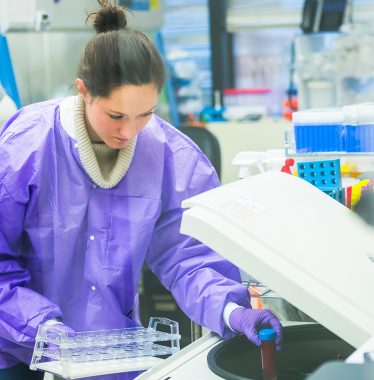 IN THESE PHOTOS
IN THESE PHOTOS
“I am processing a human blood specimen to be used in an upcoming experiment. This is an HIV negative control that we took; once you spin it down in a centrifuge, it causes a gradient of cell density. At the bottom are the most dense red blood cells, then the ficol liquid the second most dense, and slightly above are the white blood cells, and those are just floating. We suck those up and wash those. At the top is the plasma, and it’s the least dense. This is how we separate the blood cells for further processing.”
Now that one of the therapies developed by Huiting’s team has entered stage-one human clinical trials, she is helping to develop the scientific backing for “analytical treatment interruption.” When patients with HIV are going to take part in a clinical trial, they need to be taken off of their traditional drug regimens. Huiting’s research is focused on proving that a brief stint away from their daily treatment will be safe for the patients involved.
Once approved, participating patients in the clinical trial overseen by Huiting’s team will receive an injection of an HIV-specific immune antibody to try to enhance the immune system’s natural response to the virus.
Huiting, whose senior honors thesis focused on an analysis of cells related to a pre-clinical preventive HIV vaccine, says, “The rigor of Colgate really prepared me. I’m working one-on-one with world-renowned researchers, and along with the people, there are cutting-edge technology and resources here. I could not be more happy.”
Post-baccalaureate fellows at the NIH work for one to two years, depending on the lab, and they use that time to hone their analytical skills while preparing for medical or graduate school, which Huiting plans to attend this year.
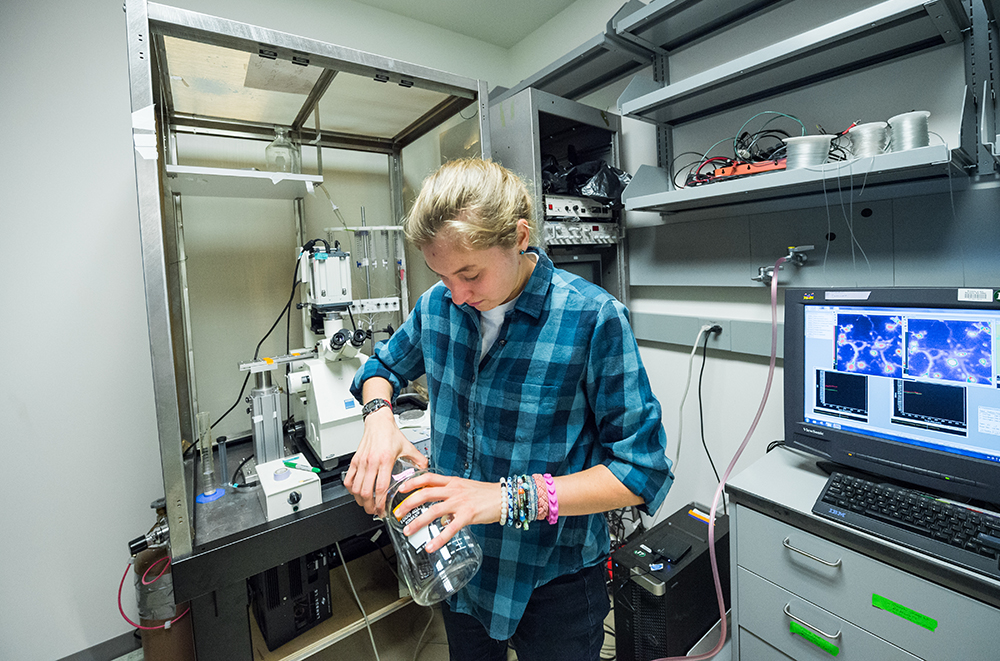
Jillian Belgrad ’17 conducts research on Gulf War Illness at the NIH
Jillian Belgrad ’17
Neuroscience major and biology minor
Weston, Mass.
Jillian Belgrad is trying to piece together a puzzle that she hopes will reveal an effective treatment for Gulf War Illness, a group of cognitive and motor disorders affecting some military veterans who served in Iraq.
“The method I use is calcium imaging,” says Belgrad as she treats a series of rat brain cells with a dye called Fura-2. By examining those cells under a high-powered microscope, Belgrad can calculate the level of calcium in the cell — an element crucial for cognitive function in the brain — to help determine how specific chemicals may be altering brain function.
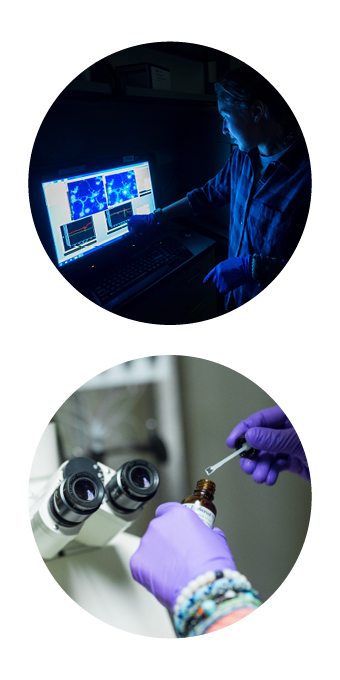 “For intercellular signaling, calcium is its currency,” Belgrad says. “Being able to use calcium to understand how cells behave under different drug treatments is really helpful. We need to know what’s happening before we can determine how to help.”
“For intercellular signaling, calcium is its currency,” Belgrad says. “Being able to use calcium to understand how cells behave under different drug treatments is really helpful. We need to know what’s happening before we can determine how to help.”
IN THESE PHOTOS
“Using the microscope and fluorescent dyes, calcium imaging allows us to record the internal responses of cells to stimuli in real time. In my lab, I am using calcium imaging to analyze the intracellular responses of a brain cell called oligodendrocytes. The brain is composed of gray matter and white matter. The white matter is formed from the fatty layers of myelin sheath that wrap the axons of neurons. The myelin sheath of the central nervous system is formed by oligodendrocytes. By analyzing the calcium responses of these cells, we can better understand factors that drive myelin plasticity, which is a crucial aspect of cognitive function and development. In these photos, I am preparing samples for calcium imaging and analyzing the dynamic cell responses using a computer program that measures changes in fluorescence.”
For Belgrad, who is a post-baccalaureate fellow at the NIH, working with brain cells and analyzing the responses to various clinical treatment experiments is like having a conversation.
“As it’s happening, it’s like the cells are responding to you, like they’re talking,” she says. “It’s exciting to see a close mirror of what is happening in the brain in real time right there.”
When Belgrad participated in Colgate’s study group in 2016, she worked in the same lab as renowned researcher R. Douglas Fields. She loved working in a lab where everyone was asking questions and trying to think of new ways to approach difficult questions about the brain.
“It’s like the cells are responding to you, like they’re talking. It’s exciting to see a close mirror of what is happening in the brain in real time right there.” – Jillian Belgrad
“This lab in particular is focused on glial cells, which is the group of cells that are not neurons in the brain. I worked in [Associate Professor of Psychology and Neuroscience] Jun Yoshino’s lab at Colgate, and he loves glial cells, so that wore off on me. Yoshino’s classes prepared me to ask questions and understand how neuroscience and biology tie together.”
Once her fellowship concludes, Belgrad will work toward an MD-PhD to continue her love of science and medicine. In the meantime, she’s enjoying working in a place that brings together researchers from so many different fields of science.
“I work in a neurology lab, but I talk with people from cancer labs, kidney labs, and gene regulation labs. It’s powerful to learn science from so many different perspectives,” Belgrad says. “I’m most proud of being able to contribute. It’s nice to have a role in a project where you know the research you’ve done is contributing to the bigger picture. We’re working together to solve different parts of the puzzle to eventually answer the problem.”
Chris Higham ’18
Neuroscience major
Toms River, N.J.
Understanding how the brain is affected by high blood pressure is the focus of the neuroscience lab where Chris Higham worked during his study group experience.
“It’s an interesting feeling to think you might be able to affect where science research is going.” — Chris Higham
“We’re investigating how brain disorders might be caused by hypertension,” he explains. Dementia and learning disabilities, but also disorders like depression and anxiety could be connected to hypertension.
“It’s an interesting feeling to think you might be able to affect where science research is going. When you’re taking classes, it’s fun to think about the applications of what you’re learning. But then getting here and actually applying what you’ve learned in school is a very different feeling — and it’s not easy.”
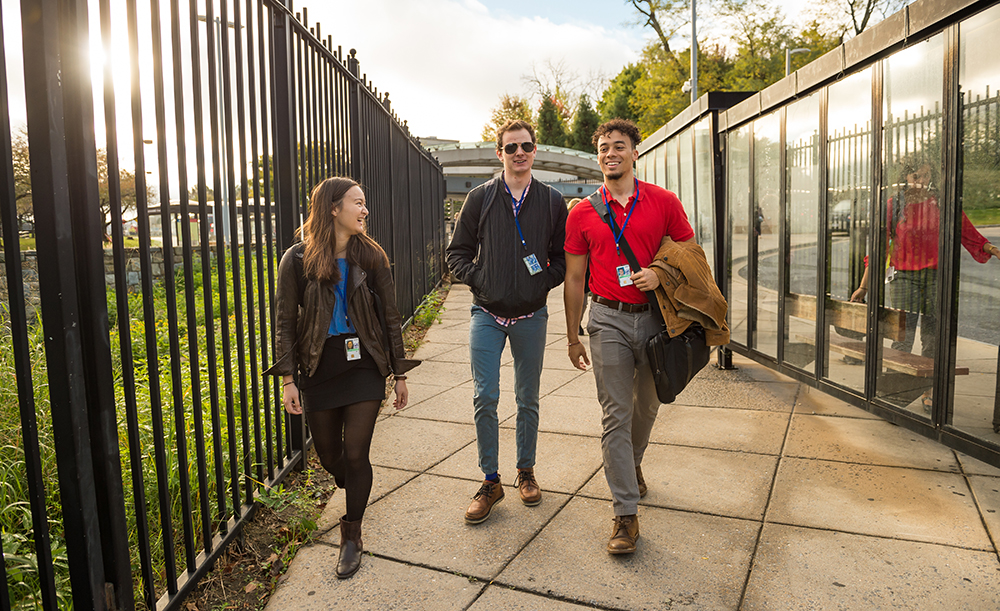
From left, Nicole Lue ’18, AJ Ward ’18, and Kasey Halsey ’18 walk to their labs on the campus of the NIH after a short commute on the Metro.
Nicole Lue ’18
Neuroscience major and religion minor
Norwalk, Conn.
For Nicole Lue, hearing researchers at the NIH discussing a “bench-to-bedside” approach to research gave added weight to her work studying how specific proteins in the brain relate to Alzheimer’s disease.
“You’re working in the lab, you’re pipetting and doing all this stuff, but this could be applied directly to patients,” Lue says. “Because the NIH has a clinical center, there are patients walking around, and these are the people whom your research is affecting.”
Part of the appeal of the NIH group — which Lue says attracted her to Colgate when she was looking at colleges — is that participants are actually part of the team developing real treatments.
“We’re not just lab techs. We’re part of the projects,” Lue says. “It’s guided by the goals of the lab, but our mentors are saying, this is your project, you get to design the experiments, you conduct the experiments, and you write up the results.”
Even though Lue and the other students are immersed in their lab work, they still find time to get away. Study group members live in an apartment complex and take the metro in to work, often solving the Washington Post crossword puzzle together.
“We find time to hang out as a study group. We went on a hike this weekend with our professor,” Lue says. “This is a completely unique opportunity that you can’t get at another school.”
AJ Ward ’18
Cellular neuroscience major
Sherborn, Mass.
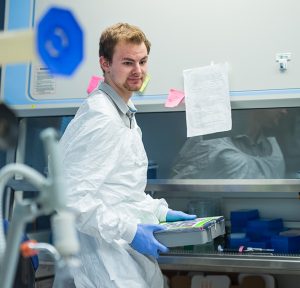
A.J. Ward ’18 works on HIV research.
Like Erin Huiting ’17, AJ Ward’s lab is focused on HIV treatment, but his work takes a different approach to the virus. He studies CD8 T Cell response to HIV, specifically in people who have lived for more than 20 years with the virus but without signs of deteriorating health.
“Their immune system is able to control the infection,” he says. “So, we’re looking at the phenotypes of the immune systems of those people and comparing those to people who get sick and progress normally. We’re seeing all sorts of differences,” Ward says. The hope is that they’ll eventually be able to use that information to create a prophylactic vaccine.
As an undergraduate at Colgate, Ward read a few papers about flow cytometry. After just a few weeks as a member of the university’s NIH study group, he uses the lab technique on a regular basis.
“Now it’s something I feel very confident about,” Ward says. “We use this machine with a matrix of lasers to excite certain antibodies to tell us the different concentration of proteins in a cell.”
Like other students on the study group, Ward attends Colgate classes twice a week after working in the lab. Each class is taught by Professor Engda Hagos; one is focused on cancer biology and treatment, while the other is a journal course in which students share the work they are doing in their labs.
“This experience has definitely influenced my career decision,” Ward says. “I want to go to medical school and specialize in infectious disease.”
NIH Numbers
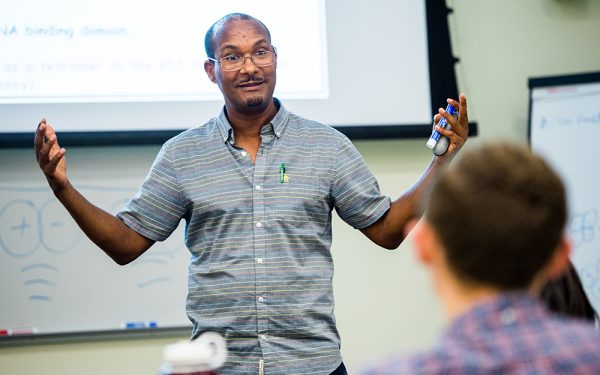
Associate Professor of Biology Engda Hagos
27 institutes and centers conducting research
>20,000 people work at the NIH
>1,200 principle investigators
>4,000 post-doctoral fellows
Watch the video for additional student perspectives, research highlights, and more:
[youtube https://www.youtube.com/watch?v=fQeRZpTUY5E&w=560&h=315]






